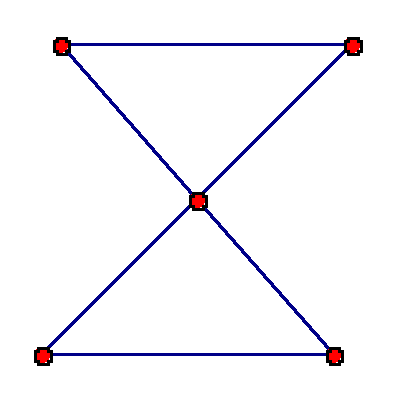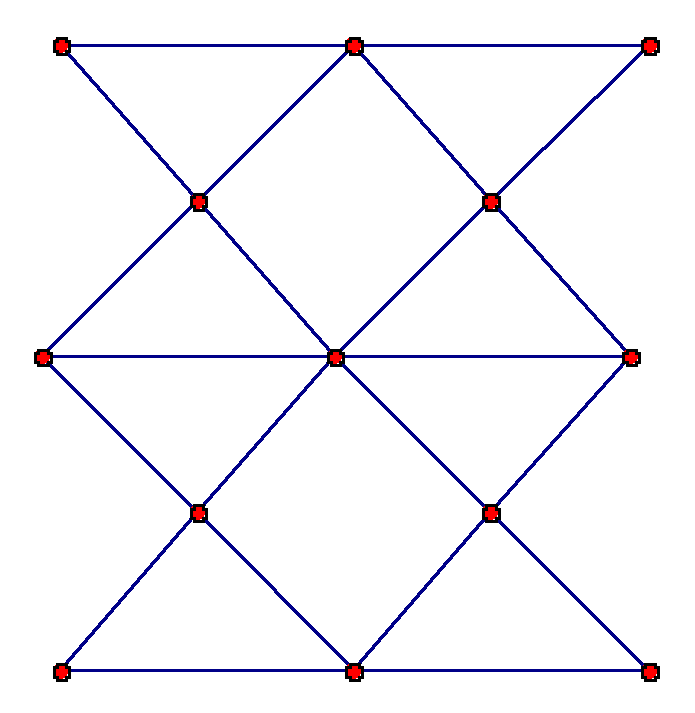5-3: Geometry in Motion
Using Translation, Rotation and Reflection, we are
going to construct a figure given a triangle.
Given the following triangle

Construct the following figure using translation, rotation, and
reflectionuse all three types of motion to complete the programexplain
your steps along the way.

Step by Step Instruction
We start with the given triangle
 a. The first step would be to rotate the figureto
put it in the right position we have to figure out the angle of
rotation. Since we want to move it halfway around in a circular
motion we rotate the figure 180 degrees. (Highlight the fixed
point you want to turn your figure around, from the "Transform"
menu select "Mark Center". Then highlight the figure
you want to rotate, from the "Transform" menu select
"Rotate". Finally type in the angle you want the figure
rotated.)
a. The first step would be to rotate the figureto
put it in the right position we have to figure out the angle of
rotation. Since we want to move it halfway around in a circular
motion we rotate the figure 180 degrees. (Highlight the fixed
point you want to turn your figure around, from the "Transform"
menu select "Mark Center". Then highlight the figure
you want to rotate, from the "Transform" menu select
"Rotate". Finally type in the angle you want the figure
rotated.)
 b. Now we can make a reflection of the new figurehere
we have to decide which line segment to flip the figure over to
achieve the desired outcome. For the outcome you desire you can
flip the figure over the top line segment or the bottom line segment.
(Highlight the line segment you want to flip the figure over,
from the "Transform" menu select "Mark Mirror".
Then highlight the figure you want to reflect, from the "Transform"
menu select "Reflect".)
b. Now we can make a reflection of the new figurehere
we have to decide which line segment to flip the figure over to
achieve the desired outcome. For the outcome you desire you can
flip the figure over the top line segment or the bottom line segment.
(Highlight the line segment you want to flip the figure over,
from the "Transform" menu select "Mark Mirror".
Then highlight the figure you want to reflect, from the "Transform"
menu select "Reflect".)
 c. The last step is to translate our new figureyou
have to determine what is called the translation vector (where
you want to position the translation both horizontally and vertically
from the original figure. Think about it as moving it along the
x and y-axis. After exploring, we can see that we need to move
it 2.5cm horizontally and 0cm vertically to get our desired outcome.
(Highlight the figure to be translated, from the "Transform"
menu select "Translate". Under "Translation Vector
select Rectangle" then put in your horizontal and vertical
distances)
c. The last step is to translate our new figureyou
have to determine what is called the translation vector (where
you want to position the translation both horizontally and vertically
from the original figure. Think about it as moving it along the
x and y-axis. After exploring, we can see that we need to move
it 2.5cm horizontally and 0cm vertically to get our desired outcome.
(Highlight the figure to be translated, from the "Transform"
menu select "Translate". Under "Translation Vector
select Rectangle" then put in your horizontal and vertical
distances)
 We have successfully constructed the desire figure
using all three motions, translation, rotation, and reflection.
We have successfully constructed the desire figure
using all three motions, translation, rotation, and reflection.







